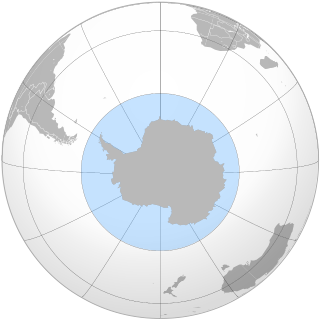
The Salish Sea is a marginal sea of the Pacific Ocean located in the Canadian province of British Columbia and the U.S. state of Washington. It includes the Strait of Georgia, Strait of Juan de Fuca, Puget Sound, and an intricate network of connecting channels and adjoining waterways.

The white-chinned petrel also known as the Cape hen and shoemaker, is a large shearwater in the family Procellariidae. It ranges around the Southern Ocean as far north as southern Australia, Peru and Namibia, and breeds colonially on scattered islands. The white-chinned petrel was formerly considered to be conspecific with the spectacled petrel.

The Southern Ocean, also known as the Antarctic Ocean, comprises the southernmost waters of the World Ocean, generally taken to be south of 60° S latitude and encircling Antarctica. As such, it is regarded as the second-smallest of the five principal oceanic divisions: smaller than the Pacific, Atlantic, and Indian oceans but larger than the Arctic Ocean. Over the past 30 years, the Southern Ocean has been subject to rapid climate change, which has led to changes in the marine ecosystem.

Codium fragile, known commonly as green sea fingers, dead man's fingers, felty fingers, forked felt-alga, stag seaweed, sponge seaweed, green sponge, green fleece, and oyster thief, is a species of seaweed in the family Codiaceae. It originates in the Pacific Ocean near Japan and has become an invasive species on the coasts of the Northern Atlantic Ocean.

The wildlife of Antarctica are extremophiles, having to adapt to the dryness, low temperatures, and high exposure common in Antarctica. The extreme weather of the interior contrasts to the relatively mild conditions on the Antarctic Peninsula and the subantarctic islands, which have warmer temperatures and more liquid water. Much of the ocean around the mainland is covered by sea ice. The oceans themselves are a more stable environment for life, both in the water column and on the seabed.
Clathria rosita is a species of sea sponge first found on the coast of South Georgia Island, in the southwest Southern Ocean.
Clathria stromnessa is a species of sea sponge first found on the coast of South Georgia island, in the south west Southern Ocean.
Clathria matthewsi is a species of sea sponge first found on the coast of South Georgia island, in the south west Southern Ocean.
Lissodendoryx collinsi is a species of demosponge first found on the coast of South Georgia island, in the south-western Southern Ocean. The discovery of Lissodendoryx collinsi and 14 other new species resulted in increasing the previously reported low sponge endemicity off South Georgia.
Hymedesmia barnesi is a species of demosponge first found on the coast of South Georgia island, in the south west Southern Ocean.
Hymedesmia pharos is a species of demosponge first found on the coast of South Georgia island, in the south west Southern Ocean.
Myxilla ponceti is a species of demosponge first found on the coast of South Georgia island, in the south west Southern Ocean.
Tedania aurantiaca is a species of sea sponge first found on the coast of South Georgia island, in the south west Southern Ocean.
Tedania wellsae is a species of sea sponge first found on the coast of South Georgia island, in the south west Southern Ocean.
Mycale brownorum is a species of demosponge first found on the coast of South Georgia island, in the south west Southern Ocean.
Mycale cartwrighti is a species of demosponge first found on the coast of South Georgia island, in the south west Southern Ocean.
Haliclona crowtheri is a species of demosponge first found on the coast of South Georgia Island, in the south west Southern Ocean.
Microxina myxa is a species of sea sponge first found on the coast of South Georgia island, in the south-western Southern Ocean.
Calyx shackletoni is a species of sea sponge first found on the coast of South Georgia island, in the south-western Southern Ocean.
Michelle Kelly, also known as Michelle Kelly-Borges, is a New Zealand scientist who specialises in sponges, their chemistry, their evolution, taxonomy, systematics, and ecology.




